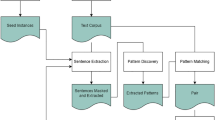Abstract
Hyponymy relations are the skeleton of an ontology, which is widely used in information retrieval, natural language processing, etc. Traditional hyponymy construction by domain experts is labor-consuming, and may also suffer from sparseness. With the rapid development of the Internet, automatic hyponymy acquisition from the web has become a hot research topic. However, due to the polysemous terms and casual expressions on the web, a large number of irrelevant or incorrect terms will be inevitably extracted and introduced to the results during the automatic discovering process. Thus the automatic web-based methods will probably fail because of the large number of irrelevant terms. This paper presents a novel approach of web-based hyponymy discovery, where we propose a term verification method based on hyponymy hierarchical characteristics. In this way, irrelevant and incorrect terms can be rejected effectively. The experimental results show that our approach can discover large number of cohesive relations automatically with high precision.
Access this chapter
Tax calculation will be finalised at checkout
Purchases are for personal use only
Preview
Unable to display preview. Download preview PDF.
Similar content being viewed by others
References
Clark, M., Kim, M., Kruschwitz, U., Song, D., Albakour, D., Dignum, S., Beresi, U., Fasli, M., Roeck, A.: Automatically structuring domain knowledge from text: An overview of current research. Information Processing and Management 48(3), 552–568 (2012)
Buitelaar, P., Cimiano, P., Magnini, B.: Ontology learning from text: methods, evaluation and applications. IOS press (2005)
Hearst, M.A.: Automatic acquisition of hyponyms from large text corpora. In: Proceedings of the 14th Conference on Computational Linguistics, vol. 2 (1992)
Hovy, E., Kozareva, Z., Riloff, E.: Toward completeness in concept extraction and classification. In: Proceedings of the 2009 Conference on Empirical Methods in Natural Language Processing, vol. 2 (2009)
Snow, R., Jurafsky, D., Ng, A.Y.: Learning syntactic patterns for automatic hypernym discovery. In: Advances in Neural Information Processing Systems (2004)
Kozareva, Z., Riloff, E., Hovy, E.H.: Semantic class learning from the web with hyponym pattern linkage graphs. In: Proceedings of ACL 2008: HLT (2008)
Sanchez, D., Moreno, A.: A methodology for knowledge acquisition from the web. International Journal of Knowledge-Based and Intelligent Engineering Systems (2006)
Cimino, P., Steffen, S.: Learning by googling. SIGKDD Explor. Newsl. 6(2) (2004)
Sanchez, D.: Learning non-taxonomic relationships from web documents for domain ontology constructions. In: Data and Knowledge Engineering (2008)
Navigli, R., Paola, V., Stefano, F.: A graph-based algorithm for inducing lexical tax- onomies from scratch. In: Proceedings of the Twenty-Second International Joint Conference on Artificial Intelligence, vol. 3, pp. 1872–1877 (2011)
Andrew, C., Justin, B., Richard, W., Hruschka, J., Estevam, R., Mitchell, T.: Coupled semi- supervised learning for information extraction. In: Proceedings of the third ACM International Conference on Web Search and Data Mining, pp. 101–110 (2010)
Pantel, P., Pennacchiotti, M.: Espresso: leveraging generic patterns for automatically harvesting semantic relations. In: Proceedings of the 21st International Conference on Computational Linguistics and the 44th Annual Meeting of the Association for Computational Linguistics (2006)
Mou, L.L., Li, G., Jin, Z., Lu, Y.Y., Hao, Y.Y.: Discovering domain concepts and hyponymy relations by text relevance classifying based iterative web searching. In: Proceedings of the 2012 Asian Parcific Software Engineering Conference (2012)
Mou, L.L., Li, G., Jin, Z.: Domain hyponymy hierarchy discovery by iterative web searching and inferable semantics based concept selecting. In: Proceedings of the 2013 IEEE 37th Annual Computer Software and Applications Conference, pp. 387–392 (2013)
Jurafsky, D., Martin, J.: Speech And Language Processing: An Introduction to Natural Language Processing, Computational Linguistics, and Speech Recognition. Prentice Hall (2009)
Author information
Authors and Affiliations
Editor information
Editors and Affiliations
Rights and permissions
Copyright information
© 2014 Springer International Publishing Switzerland
About this paper
Cite this paper
Mou, L., Li, G., Jin, Z., Zhang, L. (2014). Verification Based on Hyponymy Hierarchical Characteristics for Web-Based Hyponymy Discovery. In: Buchmann, R., Kifor, C.V., Yu, J. (eds) Knowledge Science, Engineering and Management. KSEM 2014. Lecture Notes in Computer Science(), vol 8793. Springer, Cham. https://doi.org/10.1007/978-3-319-12096-6_8
Download citation
DOI: https://doi.org/10.1007/978-3-319-12096-6_8
Publisher Name: Springer, Cham
Print ISBN: 978-3-319-12095-9
Online ISBN: 978-3-319-12096-6
eBook Packages: Computer ScienceComputer Science (R0)




